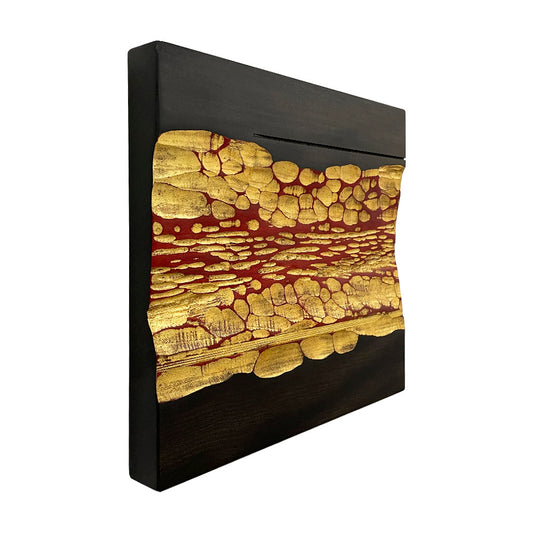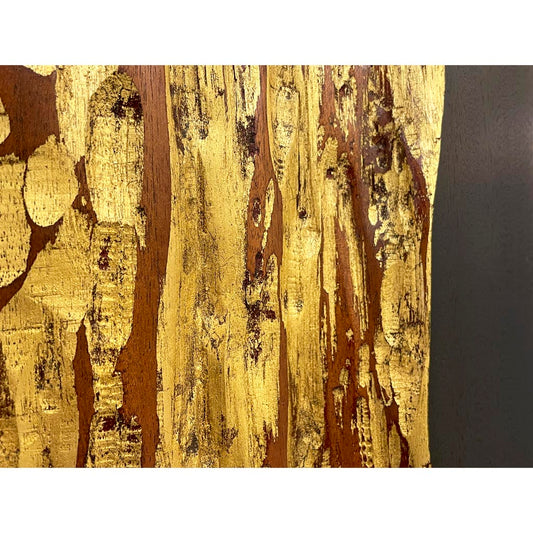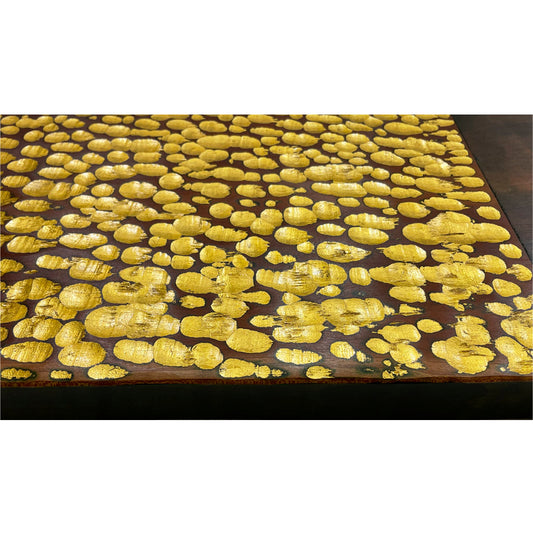JEFFREY BROSK

ARTIST BIO & STATEMENT
Jeffrey Brosk is an architect turned sculptor artist. He attended M.I.T where he mastered in Architecture and went on to discover his adoration for art after working for a construction company in Prescott, Arizona. Learning about important construction methods, Brosk recalls the captivation of the Western Landscape that ultimately changed his perspective both spiritually and aesthetically. Throughout the years the artist has combined his knowledge of architecture and his interest in painting to create uniquely large scale pieces of functional works as well as installations. The result of his harmonious forms is reminiscent of themes of Zen found in Japanese artworks, from its subtlety and focus one seems to breathe at a slower pace in response to its calmness.
Twice a year, Brosk drives to sawmills in Pennsylvania to select wood for its unusual shape and imperfections. He allows some pieces to crack as they dry, while others are kiln-dried to prevent splitting. Contrast is a key element for Brosk; rough against smooth, light against dark and warm against cool invoking both the minimalism of the East and the vastness of the American Southwest. Time and weather leave their markings where the artist then works to stain, chisel and sand before adding squares of 22-karat gold leaf or blue-gray slate to the surfaces. Brosk’s attention to color and surface difference is that of a painter, placing tree shaped slices of wood against the orderliness of machined lumber. The formal and spatial ideas explored in Brosk’s work offer a solution to the creation of interior environments with a consideration of human perception and physical environment. His functional work serves to supply the artist's appreciation for the beauty of simplicity and the complexity that lies in the details upon close contact. Both modalities are meant to establish a sense of place in the spirit of the mind.
Brosk currently lives and works out of his Soho Studio in NYC. He has been apart of group exhibitions such as Art Fiera, Bologna Italy., Max Hutchinson Gallery, NYC., North American Sculpture, Alain Oudin Gallery, Paris, France., Nina Freudenheim Gallery, Buffalo, NY., 8 Artpark Projects, Artculture Resource Center, Toronto, Canada., Museum of Arts and Design, “Permanent Collection”, New York, NY., Albemarle Gallery, London, England.; He has had solo exhibitions internationally from Stephen Rosenberg Gallery, New York, NY., Art Museum of the Americas Gallery, Washington, DC., Cultural Center of Miraflores, Lima, Peru., Museum of Fine Arts Houston, Texas., Jerusalem Biennale 2017 & 2019., Mizuma & Kips, New York, NY. Brosk has completed multiple installations and commission in recognized spaces such as the Central Synagogue, New York, NY., St. Regis Hotel, Fort Lauderdale, FL., Wise Academy, Dallas, TX., Basilica of the National Shrine of the Immaculate Conception, Washington, DC., and Chicago Sculpture International, Navy Pier, IL.
Jeffrey Brosk is an architect turned sculptor artist. He attended M.I.T where he mastered in Architecture and went on to discover his adoration for art after working for a construction company in Prescott, Arizona. Learning about important construction methods, Brosk recalls the captivation of the Western Landscape that ultimately changed his perspective both spiritually and aesthetically. Throughout the years the artist has combined his knowledge of architecture and his interest in painting to create uniquely large scale pieces of functional works as well as installations. The result of his harmonious forms is reminiscent of themes of Zen found in Japanese artworks, from its subtlety and focus one seems to breathe at a slower pace in response to its calmness.
Twice a year, Brosk drives to sawmills in Pennsylvania to select wood for its unusual shape and imperfections. He allows some pieces to crack as they dry, while others are kiln-dried to prevent splitting. Contrast is a key element for Brosk; rough against smooth, light against dark and warm against cool invoking both the minimalism of the East and the vastness of the American Southwest. Time and weather leave their markings where the artist then works to stain, chisel and sand before adding squares of 22-karat gold leaf or blue-gray slate to the surfaces. Brosk’s attention to color and surface difference is that of a painter, placing tree shaped slices of wood against the orderliness of machined lumber. The formal and spatial ideas explored in Brosk’s work offer a solution to the creation of interior environments with a consideration of human perception and physical environment. His functional work serves to supply the artist's appreciation for the beauty of simplicity and the complexity that lies in the details upon close contact. Both modalities are meant to establish a sense of place in the spirit of the mind.
Brosk currently lives and works out of his Soho Studio in NYC. He has been apart of group exhibitions such as Art Fiera, Bologna Italy., Max Hutchinson Gallery, NYC., North American Sculpture, Alain Oudin Gallery, Paris, France., Nina Freudenheim Gallery, Buffalo, NY., 8 Artpark Projects, Artculture Resource Center, Toronto, Canada., Museum of Arts and Design, “Permanent Collection”, New York, NY., Albemarle Gallery, London, England.; He has had solo exhibitions internationally from Stephen Rosenberg Gallery, New York, NY., Art Museum of the Americas Gallery, Washington, DC., Cultural Center of Miraflores, Lima, Peru., Museum of Fine Arts Houston, Texas., Jerusalem Biennale 2017 & 2019., Mizuma & Kips, New York, NY. Brosk has completed multiple installations and commission in recognized spaces such as the Central Synagogue, New York, NY., St. Regis Hotel, Fort Lauderdale, FL., Wise Academy, Dallas, TX., Basilica of the National Shrine of the Immaculate Conception, Washington, DC., and Chicago Sculpture International, Navy Pier, IL.
Twice a year, Brosk drives to sawmills in Pennsylvania to select wood for its unusual shape and imperfections. He allows some pieces to crack as they dry, while others are kiln-dried to prevent splitting. Contrast is a key element for Brosk; rough against smooth, light against dark and warm against cool invoking both the minimalism of the East and the vastness of the American Southwest. Time and weather leave their markings where the artist then works to stain, chisel and sand before adding squares of 22-karat gold leaf or blue-gray slate to the surfaces. Brosk’s attention to color and surface difference is that of a painter, placing tree shaped slices of wood against the orderliness of machined lumber. The formal and spatial ideas explored in Brosk’s work offer a solution to the creation of interior environments with a consideration of human perception and physical environment. His functional work serves to supply the artist's appreciation for the beauty of simplicity and the complexity that lies in the details upon close contact. Both modalities are meant to establish a sense of place in the spirit of the mind.
Brosk currently lives and works out of his Soho Studio in NYC. He has been apart of group exhibitions such as Art Fiera, Bologna Italy., Max Hutchinson Gallery, NYC., North American Sculpture, Alain Oudin Gallery, Paris, France., Nina Freudenheim Gallery, Buffalo, NY., 8 Artpark Projects, Artculture Resource Center, Toronto, Canada., Museum of Arts and Design, “Permanent Collection”, New York, NY., Albemarle Gallery, London, England.; He has had solo exhibitions internationally from Stephen Rosenberg Gallery, New York, NY., Art Museum of the Americas Gallery, Washington, DC., Cultural Center of Miraflores, Lima, Peru., Museum of Fine Arts Houston, Texas., Jerusalem Biennale 2017 & 2019., Mizuma & Kips, New York, NY. Brosk has completed multiple installations and commission in recognized spaces such as the Central Synagogue, New York, NY., St. Regis Hotel, Fort Lauderdale, FL., Wise Academy, Dallas, TX., Basilica of the National Shrine of the Immaculate Conception, Washington, DC., and Chicago Sculpture International, Navy Pier, IL.

"The overall exploration of the impact of the Western landscape is the basis for all the work. The emotional and spiritual connection I have with the landscape continues to be the foundation for all my artwork. A new installation specifically made for this exhibit using a mesquite log is the most current example of making work that serves as a distillation of the larger landscape." -Jeffrey Brosk
- Choosing a selection results in a full page refresh.
- Opens in a new window.




















